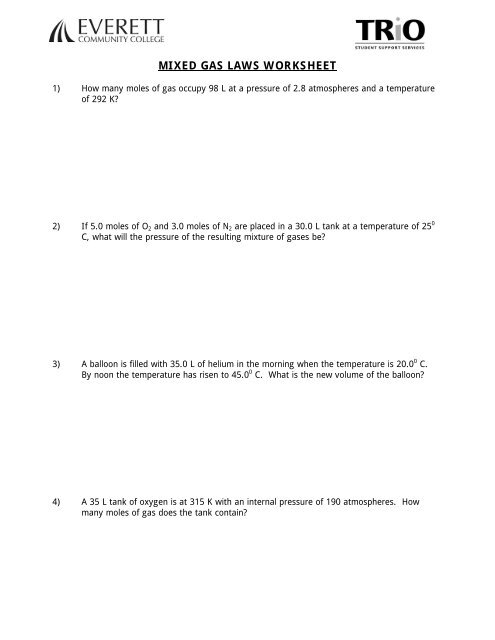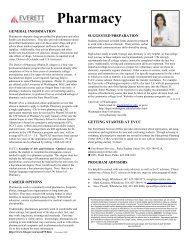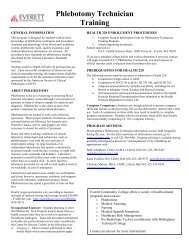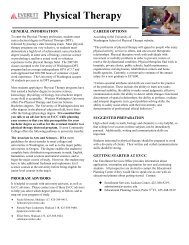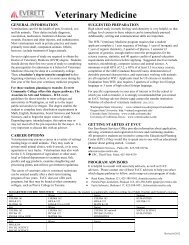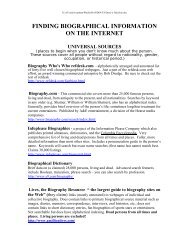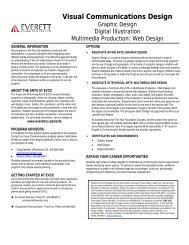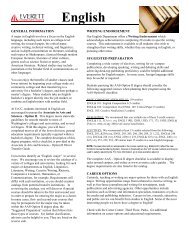Mixed Gas Laws Worksheet - Everett Community College
Mixed Gas Laws Worksheet - Everett Community College
Mixed Gas Laws Worksheet - Everett Community College
Create successful ePaper yourself
Turn your PDF publications into a flip-book with our unique Google optimized e-Paper software.
MIXED GAS LAWS WORKSHEET<br />
1) How many moles of gas occupy 98 L at a pressure of 2.8 atmospheres and a temperature<br />
of 292 K?<br />
2) If 5.0 moles of O2 and 3.0 moles of N2 are placed in a 30.0 L tank at a temperature of 25 0<br />
C, what will the pressure of the resulting mixture of gases be?<br />
3) A balloon is filled with 35.0 L of helium in the morning when the temperature is 20.0 0 C.<br />
By noon the temperature has risen to 45.0 0 C. What is the new volume of the balloon?<br />
4) A 35 L tank of oxygen is at 315 K with an internal pressure of 190 atmospheres. How<br />
many moles of gas does the tank contain?
5) A balloon that can hold 85 L of air is inflated with 3.5 moles of gas at a pressure of 1.0<br />
atmosphere. What is the temperature in 0 C of the balloon?<br />
6) CaCO3 decomposes at 1200 0 C to form CO2 gas and CaO. If 25 L of CO2 are collected at<br />
1200 0 C, what will the volume of this gas be after it cools to 25 0 C?<br />
7) A helium balloon with an internal pressure of 1.00 atm and a volume of 4.50 L at 20.0 0 C<br />
is released. What volume will the balloon occupy at an altitude where the pressure is 0.600<br />
atm and the temperature is –20.0 0 C?<br />
8) There are 135 L of gas in a container at a temperature of 260 0 C. If the gas was cooled<br />
until the volume decreased to 75 L, what would the temperature of the gas be?
9) A 75 L container holds 62 moles of gas at a temperature of 215 0 C. What is the pressure in<br />
atmospheres inside the container?<br />
10) 6.0 L of gas in a piston at a pressure of 1.0 atm are compressed until the volume is 3.5 L.<br />
What is the new pressure inside the piston?<br />
11) A gas canister can tolerate internal pressures up to 210 atmospheres. If a 2.0 L canister<br />
holding 3.5 moles of gas is heated to 1350 0 C, will the canister explode?<br />
12) The initial volume of a gas at a pressure of 3.2 atm is 2.9 L. What will the volume be if the<br />
pressure is increased to 4.0 atm?
13) An airtight container with a volume of 4.25 x 10 4 L, an internal pressure of 1.00 atm, and<br />
an internal temperature of 15.0 0 C is washed off the deck of a ship and sinks to a depth<br />
where the pressure is 175 atm and the temperature is 3.00 0 C. What will the volume of the<br />
gas inside be when the container breaks under the pressure at this depth?<br />
14) Two flasks are connected with a stopcock. Flask #1 has a volume of 2.5 L and contains<br />
oxygen gas at a pressure of 0.70 atm. Flask #2 has a volume of 3.8 L and contains<br />
hydrogen gas at a pressure of 1.25 atm. When the stopcock between the two flasks is<br />
opened and the gases are allowed to mix, what will the resulting pressure of the gas<br />
mixture be?<br />
15) A weather balloon has a volume of 35 L at sea level (1.0 atm). After the balloon is<br />
released it rises to where the air pressure is 0.75 atm. What will the new volume of the<br />
weather balloon be?
MIXED GAS LAWS WORKSHEET - SOLUTIONS<br />
1) How many moles of gas occupy 98 L at a pressure of 2.8 atmospheres and a temperature<br />
of 292 K?<br />
n = PV = (2.8 atm)(98 L)<br />
RT (0.0821 L . atm/mol . K)(292 K)<br />
= 11 moles of gas<br />
2) If 5.0 moles of O2 and 3.0 moles of N2 are placed in a 30.0 L tank at a temperature of 25 0<br />
C, what will the pressure of the resulting mixture of gases be? 25 0 C = 298 K<br />
O2: P = nRT = (5.0 mol)(0.0821 L . atm/mol . K)(298 K)<br />
V (30.0 L)<br />
N2: P = nRT = (3.0 mol)(0.0821 L . atm/mol . K)(298 K)<br />
V (30.0 L)<br />
PTot = PO2 + PN2 = 4.1 atm + 2.4 atm = 6.5 atm<br />
= 4.1 atm<br />
= 2.4 atm<br />
3) A balloon is filled with 35.0 L of helium in the morning when the temperature is 20.0 0 C.<br />
By noon the temperature has risen to 45.0 0 C. What is the new volume of the balloon?<br />
T1 = 20.0 0 C = 293 K, V1 = 35.0 L, T2 = 45.0 0 C = 318 K, V2 = ?<br />
V2 = V1 T2 = (35.0 L)(318 K)<br />
T1 (293 K)<br />
= 38.0 L<br />
4) A 35 L tank of oxygen is at 315 K with an internal pressure of 190 atmospheres. How<br />
many moles of gas does the tank contain?<br />
n = PV = (190 atm)(35 L)<br />
RT (0.0821 L . atm/mol . K)(315 K)<br />
= 260 moles of gas<br />
5) A balloon that can hold 85 L of air is inflated with 3.5 moles of gas at a pressure of 1.0<br />
atmosphere. What is the temperature in 0 C of the balloon?<br />
T = PV = (1 atm)(85 L)<br />
nR (3.5 mol)(0.0821 L . atm/mol . = 296 K = 23<br />
K)<br />
0 C<br />
6) CaCO3 decomposes at 1200 0 C to form CO2 gas and CaO. If 25 L of CO2 are collected at<br />
1200 0 C, what will the volume of this gas be after it cools to 25 0 C?<br />
T1 = 1200 0 C = 1473 K, V1 = 25 L, T2 = 25 0 C = 298 K, V2 = ?<br />
V2 = V1 T2 = (25 L)(298 K)<br />
T1 (1473 K)<br />
= 5.1 L<br />
7) A helium balloon with an internal pressure of 1.00 atm and a volume of 4.50 L at 20.0 0 C<br />
is released. What volume will the balloon occupy at an altitude where the pressure is 0.600<br />
atm and the temperature is –20.0 0 C?<br />
P1 = 1.00 atm, V1 = 4.50 L, T1 = 20.0 0 C = 293 K, P2 = 0.600 atm, V2 = ?,<br />
T2 = -20.0 0 C = 253 K<br />
V2 = P1 V1 T2 = (1.00 atm)(4.50 L)(253 K)<br />
T1P2 (293 K)(0.600 atm)<br />
= 6.48 L<br />
8) There are 135 L of gas in a container at a temperature of 260 0 C. If the gas was cooled<br />
until the volume decreased to 75 L, what would the temperature of the gas be?<br />
T1 = 260 0 C = 533 K, V1 = 135 L, T2 = ?, V2 = 75 L<br />
T2 = V2 T1 = (75 L)(533 K)<br />
V1 (135 L)<br />
= 296 K = 23 0 C
9) A 75 L container holds 62 moles of gas at a temperature of 215 0 C. What is the pressure in<br />
atmospheres inside the container? 215 0 C = 488 K<br />
P = nRT = (62 mol)(0.0821 L . atm/mol . K)(488 K) = 33 atm<br />
V (75 L)<br />
10) 6.0 L of gas in a piston at a pressure of 1.0 atm are compressed until the volume is 3.5 L.<br />
What is the new pressure inside the piston?<br />
P1 = 1.0 atm, V1 = 6.0 L, P2 = ?, V2 = 3.5 L<br />
P2 = P1 V1 = (1.0 atm)(6.0 L) = 1.7 atm<br />
V2 (3.5 L)<br />
11) A gas canister can tolerate internal pressures up to 210 atmospheres. If a 2.0 L canister<br />
holding 3.5 moles of gas is heated to 1350 0 C, will the canister explode? 1350 0 C = 1623 K<br />
P = nRT = (3.5 mol)(0.0821 L . atm/mol . K)(1623 K) = 230 atm<br />
V (2.0 L)<br />
Yes, the canister will explode.<br />
12) The initial volume of a gas at a pressure of 3.2 atm is 2.9 L. What will the volume be if the<br />
pressure is increased to 4.0 atm?<br />
P1 = 3.2 atm, V1 = 2.9 L, P2 = 4.0 atm, V2 = ?<br />
V2 = P1 V1 = (3.2 atm)(2.9 L) = 2.3 L<br />
P2 (4.0 atm)<br />
13) An airtight container with a volume of 4.25 x 10 4 L, an internal pressure of 1.00 atm, and<br />
an internal temperature of 15.0 0 C is washed off the deck of a ship and sinks to a depth<br />
where the pressure is 175 atm and the temperature is 3.00 0 C. What will the volume of the<br />
gas inside be when the container breaks under the pressure at this depth?<br />
P1 = 1.00 atm, V1 = 4.25 x 10 4 L, T1 = 15.0 0 C = 288 K, P2 = 175 atm, V2 = ?,<br />
T2 = 3.00 0 C = 276 K<br />
V2 = P1 V1 T2 = (1.00 atm)(4.25 x 10 4 L)(276 K) = 233 L<br />
T1P2 (288 K)(175 atm)<br />
14) Two flasks are connected with a stopcock. Flask #1 has a volume of 2.5 L and contains<br />
oxygen gas at a pressure of 0.70 atm. Flask #2 has a volume of 3.8 L and contains<br />
hydrogen gas at a pressure of 1.25 atm. When the stopcock between the two flasks is<br />
opened and the gases are allowed to mix, what will the resulting pressure of the gas<br />
mixture be? (P’ & V’ are initial conditions before mixing)<br />
P’O2 = 0.70 atm, P’H2 = 1.25 atm, V’O2 = 2.5 L, V’H2 = 3.8 L, V = 6.3 L<br />
O2: P2 = P’O2 V’O2 = (0.70 atm)(2.5 L) = 0.28 atm<br />
V (6.3 L)<br />
H2: P2 = P’H2 V’H2 = (1.25 atm)(3.8 L) = 0.75 atm<br />
V (6.3 L)<br />
PTot = PO2 + PH2 = 0.28 atm + 0.75 atm = 1.0 atm<br />
15) A weather balloon has a volume of 35 L at sea level (1.0 atm). After the balloon is<br />
released it rises to where the air pressure is 0.75 atm. What will the new volume of the<br />
weather balloon be?<br />
P1 = 1.0 atm, V1 = 35 L, P2 = 0.75 atm, V2 = ?<br />
V2 = P1 V1 = (1.0 atm)(35 L) = 47 L<br />
P2 (0.75 atm)<br />
<strong>Everett</strong> <strong>Community</strong> <strong>College</strong> does not discriminate on the basis of race, religion, creed, color, national origin,<br />
age, sex, marital status, disability, or veteran status.


